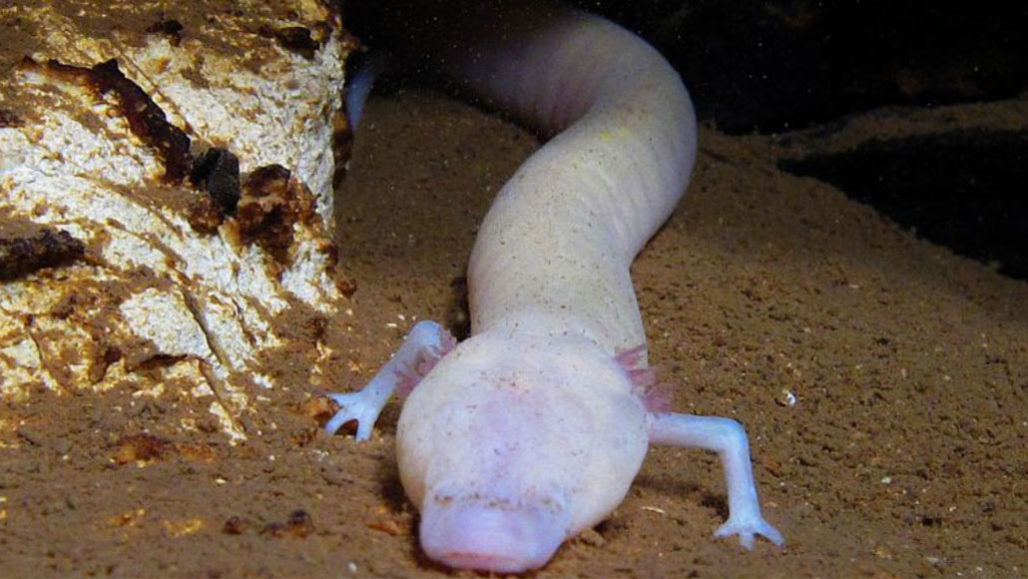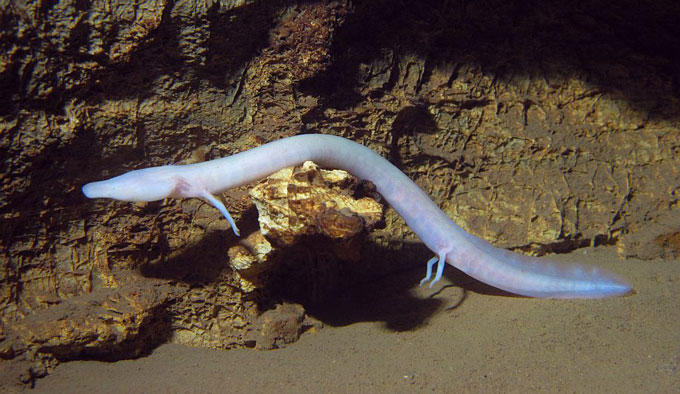One blind, aquatic salamander may have sat mostly still for seven years / Una salamandra acquatica cieca potrebbe essere rimasta ferma per sette anni
One blind, aquatic salamander may have sat mostly still for seven years / Una salamandra acquatica cieca potrebbe essere rimasta ferma per sette anni
Segnalato dal Dott. Giuseppe Cotellessa / Reported by Dr. Giuseppe Cotellessa

An olm rests on the bottom of its flooded cave home. New research suggests that the amphibians hardly move for years at a time. / Un proteo riposa sul fondo della sua caverna allagata. Una nuova ricerca suggerisce che gli anfibi difficilmente si muovono per anni.
BALÁZS LERNER AND GERGELY BALÁZS/PROTEUS PROJECT
Low-energy olms can go years without food and may live for about a century.
Once upon a time, olms knew the cool drizzle of rain and bathed in the glow of the sun. But millions of years ago, these aquatic salamanders moved to underwater caves beneath southeastern Europe’s Dinaric Alps and evolved into the pale, blind, foot-long creatures known today (SN: 4/20/16).
Now, a study reveals one trait that may help olms inhabit these caverns that have little food: The salamanders don’t seem to move much. One olm even appeared to haunt roughly the same spot for seven years within a limestone cave in eastern Bosnia-Herzegovina, researchers report online January 28 in the Journal of Zoology.
The pitch-black cave was seemingly full of the creatures when zoologist Gergely Balázs of Eötvös Loránd University in Budapest and his colleagues began searching for olms (Proteus anguinus) about 10 years ago. After repeated dives in the cave, the researchers began to suspect that they were seeing the same olms in the same spots each time.
So starting in 2010, the team used an injectable liquid marker to tag 26 olms found in the cave. Using a unique marking pattern for each olm, the researchers could recognize the salamanders by sight, recording how far each olm moved between sightings over eight years. In addition to the one extremely sedentary olm, most of the others didn’t seem to move more than 10 meters from their original spots over several years, the scientists found.

With a body like an eel, an olm can propel itself quickly through pitch-black waters if needed, but most of the salamanders appear to prefer a sedentary life. / Con un corpo come un'anguilla, un proteo può spingere rapidamente se stesso attraverso acque nere come la pece, ma la maggior parte delle salamandre sembra preferire una vita sedentaria.BALÁZS LERNER AND GERGELY BALÁZS/PROTEUS PROJECT
Olms could be considered extreme couch potatoes. A slow pace of life — punctuated roughly every 12 years by the need to reproduce — helps to conserve energy over a life span that can last for roughly 100 years, the researchers say. Energy conservation is paramount in these caves. With little to go around of the crustaceans and snails that olms eat, the salamanders can go 10 years without eating.
Alternatively, the olms might have wandered all over the cave but returned to rest on the same spot in time for the researchers’ next visit — a scenario Balázs thinks is less probable.
“They are really good swimmers,” Balázs notes. So the eel-like olms could “move around and try different spots to see if the neighbor is nicer, or there’s more prey … or whatever. And they just don’t do it.”
Other amphibians that tend to stick to one location typically depend on exceptionally unique microhabitats — such as the water-filled leaves of a single bromeliad plant, or beneath a specific stone. Olms live in a place where suitable habitat is spread throughout long, winding cave systems, within which the density of prey is more or less steady. There’s not very much food, but it’s evenly distributed, Balázs says. So there may be no real benefit to moving in an environment where the chances of snatching up small crustaceans or snails are the same everywhere, he says.
Cave biologist Matthew Niemiller of the University of Alabama in Huntsville agrees. “If you’re a salamander trying to survive in this … food-poor environment and you find a nice area to establish a home or territory — why would you leave?”
ITALIANO
I protei a bassa energia possono passare anni senza cibo e possono vivere per circa un secolo.
Una volta, il proteo conosceva la fresca pioviggine della pioggia e faceva il bagno nel bagliore del sole. Ma milioni di anni fa, queste salamandre acquatiche si trasferirono nelle grotte sottomarine al di sotto delle Alpi Dinariche dell'Europa sud-orientale e si evolvono nelle creature pallide, cieche, lunghe un piede come conosciute oggi (SN: 20/04/16).
Ora, uno studio rivela un tratto che può aiutare i protei ad abitare queste caverne che hanno poco cibo: le salamandre non sembrano muoversi molto. Un proteo sembrava addirittura posizionarsi all'incirca nello stesso punto per sette anni all'interno di una grotta calcarea nella Bosnia-Erzegovina orientale, come i ricercatori riportano online il 28 gennaio sul Journal of Zoology.
La caverna nera come la pece era apparentemente piena di creature quando lo zoologo Gergely Balázs dell'Università Eötvös Loránd di Budapest e dei suoi colleghi iniziarono a cercare protei (Proteus anguinus) circa 10 anni fa. Dopo ripetute immersioni nella grotta, i ricercatori hanno iniziato a sospettare che vedessero sempre gli stessi protei negli stessi punti.
Quindi, a partire dal 2010, il gruppo ha utilizzato un marker liquido iniettabile per contrassegnare 26 olmi trovati nella grotta. Utilizzando un modello di marcatura unico per ogni proteo, i ricercatori hanno potuto riconoscere le salamandre a vista, registrando la distanza percorsa da ogni olmo tra gli avvistamenti per otto anni. Oltre a quello estremamente sedentario, la maggior parte degli altri non sembra muoversi a più di 10 metri dai loro punti originali per diversi anni, come gli scienziati hanno scoperto.
Un ritmo lento della vita - variato all'incirca ogni 12 anni dalla necessità di riprodursi - aiuta a conservare l'energia per una durata che può durare per circa 100 anni, dicono i ricercatori. Il risparmio energetico è fondamentale in queste grotte. Con poco da fare tra i crostacei e le lumache che mangiano, le salamandre possono passare 10 anni senza mangiare.
In alternativa, i protei potrebbero aver vagato per tutta la caverna ma essere tornati a riposare nello stesso punto in tempo per la prossima visita dei ricercatori - uno scenario che Balázs ritiene sia meno probabile.
"Sono davvero bravi nuotatori", osserva Balázs. Quindi i protei simili ad anguille potrebbero “muoversi e provare diversi punti per vedere se il vicino è più bello, o se ci sono più prede ... o qualsiasi altra cosa. E semplicemente non lo fanno. "
Altri anfibi che tendono ad attaccarsi a una posizione dipendono in genere da microhabitat eccezionalmente unici - come le foglie piene d'acqua di una singola pianta di bromelia o sotto una pietra specifica. Gli olmi vivono in un luogo in cui è diffuso l'habitat adatto attraverso lunghi e tortuosi sistemi di grotte, all'interno dei quali la densità della preda è più o meno costante. Non c'è molto cibo, ma è distribuito uniformemente, dice Balázs. Quindi potrebbe non esserci alcun beneficio reale nel muoversi in un ambiente in cui le possibilità di strappare piccoli crostacei o lumache sono le stesse ovunque, dice.
Il biologo della caverna Matthew Niemiller dell'Università dell'Alabama di Huntsville è d'accordo. "Se sei una salamandra che cerca di sopravvivere in questo ... ambiente povero di cibo e trovi una bella zona per stabilire una casa o un territorio - perché dovresti andartene?"
Da:



Commenti
Posta un commento